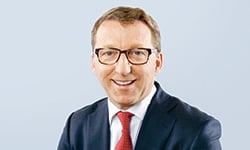Risk and capital management
Our capital strength and financial flexibility enable us to profitably grow our business within the boundaries set by our risk appetite and risk tolerance.
Overview
A solid capital position combined with financial flexibility
In 2015 we continued to be very strongly capitalised and to apply our risk appetite framework, which establishes the overall approach through which we practise controlled risk-taking throughout our Group.

“Our Group capitalisation remains very strong.”
David Cole
Group Chief Financial Officer

“Risk Management is key to controlled risk-taking that underpins our financial strength.”
Patrick Raaflaub
Group Chief Risk Officer
Capitalisation
Throughout 2015 we held capital well in excess of applicable external capital adequacy requirements. Under the Swiss Solvency Test (SST), the Group’s regulatory capitalisation was 223%, as submitted to the Swiss Financial Market Supervisory Authority (FINMA) in April 2015. The Group SST economic capitalisation at the end of 2015 is estimated at above 200%. Rating agencies A.M. Best, Moody’s and Standard & Poor’s (S&P) rated Swiss Re’s financial strength ‘superior,’ ‘excellent’ and ‘very strong’, respectively (see Capital management).
Our overall goal for capital management is to maintain a capital structure that operates efficiently within the above constraints and maximises our financial flexibility. Our underwriting and investment decisions are steered to make capital and liquidity fungible to the Group wherever possible, while complying with local regulations and client needs. Cash dividends paid to the Group’s parent holding company, Swiss Re Ltd, totalled USD 3.7 billion in 2015.
In 2015 we also passed two major milestones in optimising the capital structure of our Business Units and the Group:
- Swiss Re Ltd established a USD 700 million subordinated debt facility in November 2015, further enhancing the Group’s financial flexibility (see Capital management).
- Secondly, we achieved USD 6 billion of net deleveraging ahead of our 2016 target of USD 4 billion announced at the June 2013 Investors’ Day.
Based on the Group’s capital strength, the Board of Directors propose an 8.2% increase in the 2015 regular dividend to CHF 4.60 per share. In addition, the Board of Directors proposes a public share buy-back programme of up to CHF 1.0 billion purchase value, exercisable until the AGM in 2017.
Liquidity
Our core insurance and reinsurance operations generate liquidity primarily through premium income. Our exposure to liquidity risk stems mainly from two sources: the need to cover potential extreme loss events and regulatory constraints that limit the flow of funds within the Group.
The amount of liquidity held is largely determined by internal liquidity stress tests, which estimate the potential funding requirements stemming from extreme loss events. Based on these internal liquidity stress tests, we estimate that the Swiss Reinsurance Company Ltd liquidity pool, the primary liquidity pool of the Group, holds surplus liquidity. Swiss Re also provides FINMA with a yearly report on its liquidity position, in accordance with FINMA’s circular 13/5, “Liquidity ‒ Insurers”.
Our risk profile in 2015
Throughout 2015, our overall risk exposure increased by 3% to USD 19.6 billion, compared to USD 19.1 billion in 2014. The increase was mainly driven by higher financial market and credit risk exposure as a result of the inclusion of Guardian Financial Services. The agreement to acquire Guardian Financial Services was announced on 23 September 2015 (subject of regulatory and competition authority clearance). The acquisition was completed on 6 January 2016. As Swiss Re applies an economic-based risk and solvency assessment, asset and liability risk impacts of the acquisition are taken into account in 2015.
On the insurance risk side, our property and casualty risk slightly increased due to continued reductions in our external hedging. At the same time, our overall life and health risk decreased, mainly driven by the strengthening of the US dollar.
Risk Management
Our proprietary integrated risk model provides a meaningful assessment of the risks to which the Group is exposed and represents an important tool for managing our business. It determines the capital requirements for internal purposes and forms the basis for regulatory reporting under the SST and Solvency II for our legal entities in continental Europe.
We continuously review and update our internal model and its parameters to reflect our experiences and changes in the risk environment and current best practice.
Risk Management is embedded throughout our business. For each Business Unit, we have dedicated Chief Risk Officers and risk experts who analyse and challenge business decisions. They apply a consistent Enterprise Risk Management approach across the Group to ensure a fully integrated view of risk, and enable sustainable commercial success for Swiss Re. The independence of the Business Unit CROs is maintained by a direct reporting line to the Group Chief Risk Officer.
Swiss Re’s Risk Management function is an integral part of our business model and key to the controlled risk-taking that underpins our financial strength. Risk Management is mandated to ensure that the Group and its Business Units have the necessary expertise, frameworks and infrastructure to support good risk-taking. In addition, it monitors and ensures adherence to applicable frameworks and also performs reserving and reporting activities.